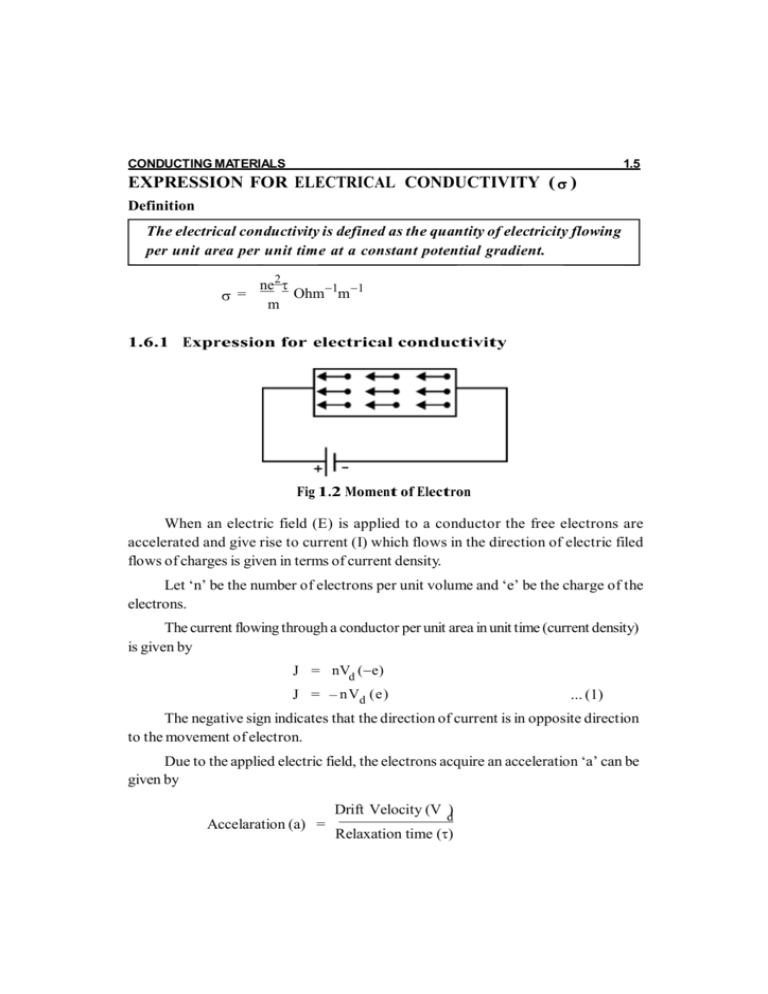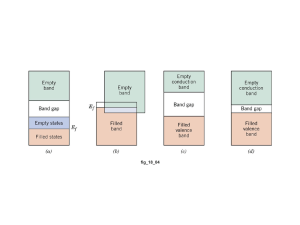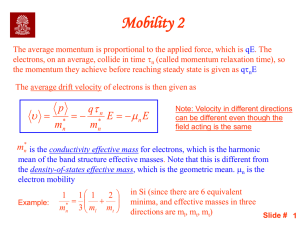1.7 thermal conductivity
advertisement

CONDUCTING MATERIALS 1.5 EXPRESSION FOR ELECTRICAL CONDUCTIVITY ( ) Definition The electrical conductivity is defined as the quantity of electricity flowing per unit area per unit time at a constant potential gradient. ne2 Ohm1m 1 = m 1.6.1 Expression for electrical conductivity Fig 1.2 Moment of Electron When an electric field (E) is applied to a conductor the free electrons are accelerated and give rise to current (I) which flows in the direction of electric filed flows of charges is given in terms of current density. Let ‘n’ be the number of electrons per unit volume and ‘e’ be the charge of the electrons. The current flowing through a conductor per unit area in unit time (current density) is given by J = nVd (e) J = – n Vd ( e ) ... (1) The negative sign indicates that the direction of current is in opposite direction to the movement of electron. Due to the applied electric field, the electrons acquire an acceleration ‘a’ can be given by Accelaration (a) = Drift Velocity (V d) Relaxation time () 1.6 ENGINEERING PHYSICS - II a = Vd Vd = a ... (2) When an electric field of strength (E) is applied to the conductor, the force experienced by the free electrons in given by F = – eE ... (3) From Newton’s second Law of motion, the force acquired by the electrons can be written as F = ma ... (4) Comparing equation (3) & (4) –eE = ma a = e E m ... (5) Now, substituting the value of ‘a’ from the equation (2),we get Vd = eE m ... (6) Substitute equation (6) in (1) eE J = n (e) m J = The electrical conductivity = = ne 2 E m J E ne2 m ne 2 ... (7) The electrical conductivity m The electrical conductivity of a material is directly proportional to the free electron concentration in the material. 1.6 1.7 THERMAL CONDUCTIVITY (K) ENGINEERING PHYSICS - II Definition The thermal conductivity is defined as the amount of heat flowing through an unit area per unit temperature gradient. = Q Wm 1 1 K dT A dx The negative sign indicates that heat flows hot end to cold end. Where K is the thermal conductivity of metal. Q is the amount of heat energy. dT is the temperature gradient. dx In general, the thermal conductivity of a material is due to the presence of lattice vibrations (ie., photons and electrons). Hence the total thermal conduction can be written as. K t ot al = K electron K photons 1.7.1 Expression for thermal conductivity (K) of an electron Consider a metal bar with two planes A and B separated by a distance ‘’ from C. Here T1 is hot end and T2 is cold end. ie., T1 > T2 1.8 ENGINEERING PHYSICS - II A C Direction of T 1 flow of heat B T2 Fig.1.3 Thermal Conductivity Let ‘n’ be the number of conduction electrons and ‘v’ be the velocity of the electrons. K B is the Boltzmann constant From kinetic theory of gases Energy of an electron at A = = 1 mv 2 2 3K BT1 2 ... (1) The kinetic energy of an electron at B = = The net energy transferred from A to B 1 mv 2 2 3K BT2 2 ... (2) 3K B (T1 T2 ) ... (3) 2 Fig.1.4 moment of electron field Let as assume that there is equal probability for the electrons to move in all the six directions. Each electrons travels with thermal velocity ‘V’ and ‘n’ is the free electron density then on average of 1/6 nv electron will travel in any one direction. CONDUCTING MATERIALS 1.9 No. of electrons crossing per unit area in unit time at C 1 nv 6 = ... (4) (Average energy transfer from A to B) The energy carried by Q the electrons from A to B (No of electron cros sin g per unit area) 3K B (T1 T2 ) 1 6 nv 2 Q = 1 K (T T )nv Q = 4 B 1 2 ... (5) We know that the thermal conductivity, Q dT A dx K = The heat energy transferred per unit sec per unit area Q = K dT dx [A=1 unit area] K(T1 T2 ) Q = 2 ... (6) dT T1 T2 , dx 2 Comparing equations (5) and (6), K(T1 T2 ) 2 = Thermal conductivity K = Thermal conductivity K 1 K (T T )nv 4 B 1 2 1 KB nv 2 K B nv 2 CONDUCTING MATERIALS 1.9







